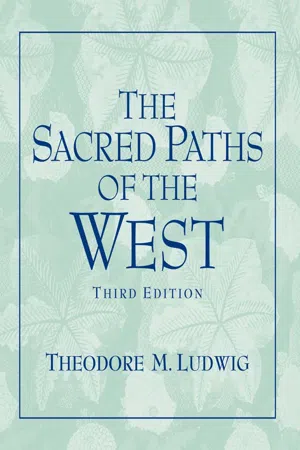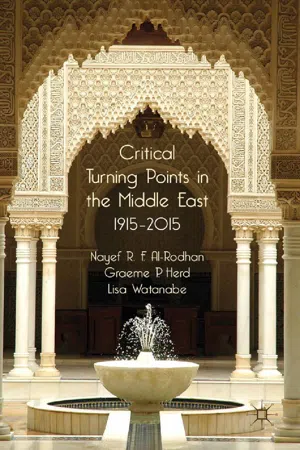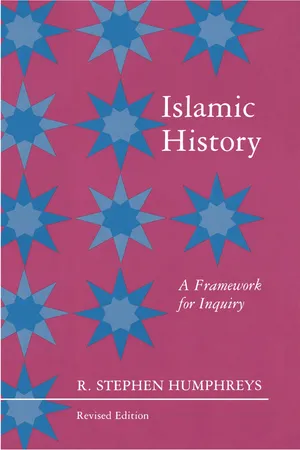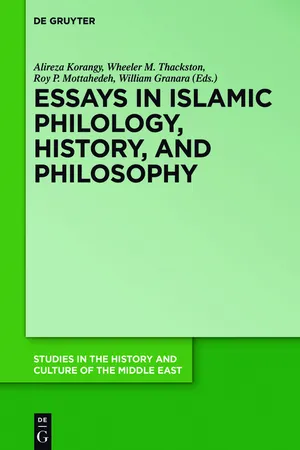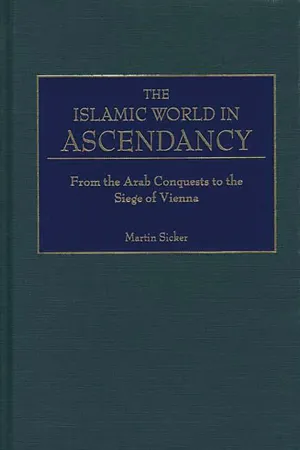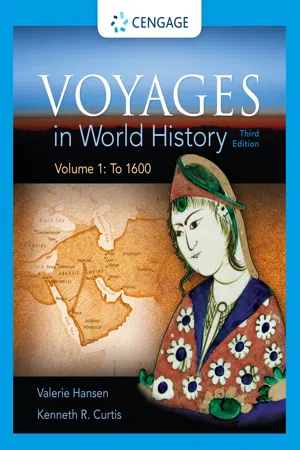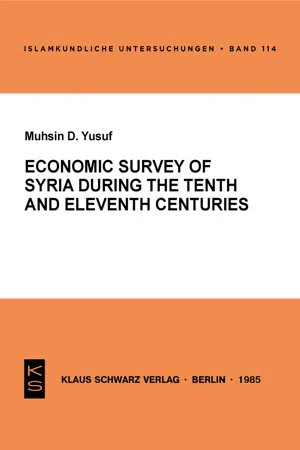History
Abbasid Dynasty
The Abbasid Dynasty was a powerful Islamic caliphate that ruled from 750 to 1258, with its capital in Baghdad. It is known for its significant contributions to Islamic culture, art, and science, as well as for its establishment of a sophisticated administrative system. The dynasty's rule saw the flourishing of Islamic civilization and the preservation and translation of classical Greek texts.
Written by Perlego with AI-assistance
Related key terms
1 of 5
10 Key excerpts on "Abbasid Dynasty"
- eBook - ePub
Muslim Identities
An Introduction to Islam
- Aaron W. Hughes(Author)
- 2013(Publication Date)
- Columbia University Press(Publisher)
ʿ i-inspired dynasty, the Fatimids, in 1003.By the early tenth century, the Abbasids risked losing control of Iraq, their power base, to various emirates. In 945, for example, one of these regional dynasties, the Buyids, took over Baghdad and made the caliph into a puppet ruler for those with actual military power. In the eleventh century, the loss of respect for the caliphs continued; some of the provincial rulers no longer mentioned the caliph’s name in the Friday religious sermons and struck it off their coinage. Although the Abbasids gradually regained some of their old strength in the late twelfth century, they were no match for the Mongols, who on February 10, 1258, destroyed the city of Baghdad.The Abbasid Dynasty was, however, eventually resurrected as a way to legitimize the power of the Mamluk dynasty centered in Cairo. Mamluk is the word for the Turkish “slaves” that the Abbasids had imported earlier to serve as the army for their caliphate. Although the Mamluks used the mantle of the Abbasids, they certainly had no pretenses regarding the universal government of all Muslims. They did, however, hold out against the Mongol attacks. In 1519, though, the Ottomans from Anatolia (Turkey) conquered the Mamluk dynasty, and the capital was moved from Cairo to Constantinople.The View from the EdgeIn an important study, historian Richard W. Bulliet correctly cautions against assuming that all the important theological and intellectual developments in the gradual emergence of Islam took place in caliphal courts among Arab elites. Islam, in other words, was not invented there and then sent out to the provinces for its various inhabitants to assent to. On the contrary, numerous Islams—with all sorts of local colors and teachings—were scattered throughout the vast Islamic Empire. The Islam of Córdoba, for example, would not necessarily be the Islam of Cairo or the Islam of Baghdad. Local religious authority, Bulliet argues, was based on local hadiths and in local systems of interpretation by locally prominent families of religious scholars.20 - eBook - ePub
- Theodore M Ludwig(Author)
- 2015(Publication Date)
- Routledge(Publisher)
Abbasids, after Muhammad’s paternal uncle al-‘Abbas, they proposed restoring rule to caliphs who were of the house of the prophet—thus attracting the support of the Shi‘ites. The mawali also joined them, their army including many soldiers from Iran.The Abbasid rulers brought Islam to its golden age. It was multicultural and international, and scholarship, literature, and the arts flourished as never before. Shortly after taking rule in about 750, the Abbasids removed the capital to a new Madinat al-Salam (City of Peace) on the Tigris River called Baghdad. There the caliphs ruled much in the style of Persian oriental kings, enjoying such titles as “the Presence” and “the Caliph of God.” The fabulous culture of Baghdad under these caliphs is reflected in some of the stories of the Arabian Nights, at the time of the famous caliph Harun al-Rashid (786–809). Baghdad society here seems worlds away from the Arabic culture of the Quran. In Baghdad the caliph of God had absolute power of life and death. It is said that officials going into the inner rooms of the Presence routinely carried their shroud on their arms in case they should displease the caliph and meet instantaneous execution. Here were viziers (ministers) with lavish palaces, poets, slaves, eunuchs and harems, exotic travel, and great wealth and luxury.Important for Islamic history was the surge of scholarship that took place under the Abbasids. A great library was built in Baghdad, and scholars translated Greek and Syriac works into Arabic. Now Aristotle and Plato became known to Muslim scholars, and they turned their attention to questions of reason and revelation and of divine power and human will. Muslim culture and learning flourished in other areas as well. In Muslim Spain, with its capital at Cordova, a rival caliphate ruled, a remnant of the Umayyad family, under which a brilliant Islamic scholarly culture was cultivated. And in Egypt a Shi‘ite dynasty managed to establish itself as another rival to the Abbasids. Calling themselves Fatimids (after Fatima, daughter of Muhammad and wife of’Ali), they founded the city of Cairo and established the famous university Al-Azhar. - eBook - PDF
Critical Turning Points in the Middle East
1915 - 2015
- N. Al-Rodhan, G. Herd, L. Watanabe(Authors)
- 2011(Publication Date)
- Palgrave Macmillan(Publisher)
They benefited from the support of the greater part of the army that was mainly composed of Sunni Turks. It was under their reign that the revival of Sunni Islam was initiated, with the construction of religious schools and a return to tra- ditionalism. One has to recall that before their conquests, a majority of regions were under Shiite rule (for example, the Buwayhid and Fatimid dynasties). However, unity was short-lived. Internal conflicts arose in the late 1090s and the process of political fragmentation resumed again. The Empire broke up into numerous states – once more the symbolic authority of the Abbasid rulers was preserved. As a reaction to the massacres that occurred in the overthrow of the Umayyads, Al-Andalus was split as a separate entity under the last sur- viving Umayyad prince (Abdul Rahman I Al-Dakhil). Only Al-Andalus The Historical Legacy 45 remained in the hands of the Umayyads. There, Abd al-Rahman I, the only member of the ruling family who had managed to flee, created the Emirate of Cordoba in 756. Within the Caliphate, an increase in narrow-mindedness became more prevalent as the ‘gates’ of ijtihad (independent reasoning) began to close. There were, of course, variations depending on time and place. Yet, gradually, Muslim societies tended to become less open and more defen- sive. External assaults, such as the crusades, accelerated this tendency, contributing powerfully to the introverted assertion of identities. The decrease in tolerance had a direct influence on the development of intellectual life in the Middle East. During the Abbasid golden age, in the eighth and ninth centuries – and even beyond – the Arab-Islamic world was the leader in all fields. It shone in science, medicine, art, architecture and so on. Imperial subjects had a strong desire to learn and innovate. They drew their inspiration and benefited from their interactions with other cultures, past and present. - eBook - PDF
Islamic History
A Framework for Inquiry - Revised Edition
- R. Stephen Humphreys(Author)
- 2020(Publication Date)
- Princeton University Press(Publisher)
All this speaks very highly of the persuasiveness and durability of the basic interpretive framework devised by van Vloten and Wellhausen. As to the social milieu within which the Revolution occurred, something has been done, but clearly there is a long way to go. We still have no exact picture of the social, economic, and religious discontents in Khurasan which the Abbasids were able to mobilize. Perhaps a comparative study of other messianic outbursts against established authority in medieval Islam would suggest some productive lines of inquiry in this re-gard. Finally, we return to our initial problem—was the Abbasid seizure of power truly a revolution? An answer to this question cannot be given until we have an integrated interpretation of Islamic society (especially in Iraq and Iran) in the half-century between 725 and 775. Such an interpretation, in turn, must wait upon monographic studies of administration, land tenure, urban develop-ment, political recruitment and participation during this period. These will surely be slow in coming, but studies of this kind will provide the most chal-lenging field of investigation during the coming years. Chapter Five BAYHAQl AND ffiN TAGHRIBIRDI THE ART OF NARRATIVE IN ISLAMIC HISTORICAL WRITING DURING THE MIDDLE PERIODS These stories may be far from history, where one usually reads that a certain king sent a certain general to such and such a war, and that on such and such a day they made war or peace, and that this one defeated that one or that one this one, and then proceeded somewhere. But I write what is worthy to be recorded. (Abu al-Fadl Bayhaqi, Tarikh-i Mas Mi) I N AMERICAN and modern European history the study of politics is based on an analysis of the direct traces of political action—the correspondence and diaries of participants, official reports, records of parliamentary de-bates, etc. These materials are of course shot through with errors, falsehoods, partisanship, and personal rancor. - Alireza Korangy, Wheeler M. Thackston, Roy P. Mottahedeh, William Granara, Alireza Korangy, Wheeler M. Thackston, Roy P. Mottahedeh, William Granara(Authors)
- 2016(Publication Date)
- De Gruyter(Publisher)
Part IV: Islamic History and Historiography Chase F. Robinson Al-ʿAṭṭāf b. Sufyān and Abbasid Imperialism It might be said that ours is a postcolonial world of neo-imperialism, but the con-fusion does not end there: describing empires in history, as a growing body of literature teaches us, is no simple thing.1 What do Islamic historians mean when they speak or write about the Abbasid “Empire”? In what follows I shall argue that this shorthand designation deserves the kind of careful scrutiny that the philologist characteristically applies to a text: swords may be more truthful than books,2 but it is with words that we think, learn and teach. More than a generation of scholarship has outlined some of the ways in which political and social elites exercised authority and power—so much so, in fact, that one can even discern a chastening critique of crudely absolutist models of pre-modern Islamic politics.3 This said, much more remains to be done, especially to take down the bogey of an early Abbasid Empire as monolithic hegemon. In what ways does speaking of empire advance or impede our understand-ing of how social and political power was exercised in the late eighth century, the very heyday of Abbasid rule? I approach the problem inductively. First I shall examine events that took place in the northern Iraqi city of Mosul in 177/793–94, when, at the hands of a certain al-ʿAṭṭāf b. Sufyān al-Azdī, it temporarily fell out of the political community that we usually call the “Abbasid Empire.” Little of sig-1 The literature is huge, but a reasonable start can be had in P. F. Bang and W. Scheidel, eds., The Oxford Handbook of the State in the Ancient Near East and Mediterranean (New York: Oxford University Press, 2013); Bang and C. A. Bayly, eds., Tributary Empires in Global History (Bas-ingstoke and New York: Palgrave Macmillan, 2011); J.- eBook - PDF
- Erik Ringmar(Author)
- 2019(Publication Date)
- Open Book Publishers(Publisher)
As a result, territories in which no Arabic speakers had previously existed, such as Egypt, were Arabized for the first time. And with Arabization, in many cases, came conversion to Islam. Yet no amount of administrative reorganization could stop political conflicts from tearing this caliphate apart too. In the middle of the eighth century, the Umayyads were challenged by new regional elites, in particular by the governors of Iraq, a fertile and rich part of the empire. Before long a new civil war, the Second Fitna, broke out. In 750 the Umayyads were decisively defeated and the Abbasid Caliphate, 750–1258, took their place. The Abbasids claimed descent from Abbas, Muhammad’s youngest uncle. Their first capital was Kufa, in southern Iraq, but in 762 they constructed a new capital in Baghdad. It was soon to become the largest and richest city in the world and a great center of culture and learning. In Baghdad many cultures mixed freely and, much as elsewhere in the Muslim world, the dhimmi were given the right to run their own affairs. During the Abbasid Caliphate, the influences from Persia and Central Asia were strong. Persians, or rather Arabized Persians, were employed in the administration of the caliphate as advisers and judges, and Persian scholars and artists populated the caliph’s court. Cultural influences did not only come from Persia, however, but also from far further afield. From the Indians the Arabs learned about the latest advances in mathematics. Read more: Indian mathematics at p. 48. Through exchanges with China, the Arabs came to master the secrets of paper-making and soon a paper mill was established in Baghdad. Since paper is far cheaper to produce than parchment or papyrus, it was suddenly possible to gather far larger collections of books. Libraries were established throughout the caliphate which contained hundreds of thousands of volumes. At the time, the caliph’s library in Baghdad had the largest collection of books in the world. - eBook - PDF
The Islamic World in Ascendancy
From the Arab Conquests to the Siege of Vienna
- Martin Sicker(Author)
- 2000(Publication Date)
- Praeger(Publisher)
Page 28 provoked another uprising, forcing him to flee to Egypt with the Abbasids in hot pursuit. He was eventually found and killed in the Fayyum in August 750, bringing a definitive end to the Umayyad Empire. NOTES 1. Thomas W. Arnold, The Caliphate, pp. 24–25. 2. Theophanes, The Chronicle of Theophanes, p. 63. 3. Muhammad A. Enan, Decisive Moments in the History of Islam, pp. 112–113. Page 29 3 The Abbasid Empire The Abbasid seizure of the caliphate and political power in the Muslim world represented far more than a mere change of dynasty. It precipitated an even more dramatic change than the subjugation of the early Hashemites by the Umayyads and the transfer of power from Medina to Damascus. The Umayyad Empire was essentially a Mediterranean power. Syria, Palestine, and Egypt had been part of the GraecoRoman world for more than a millennium, and Persia, Turkestan, and the Punjab had been colonies of this Mediterraneancentered empire. The Abbasids, on the other hand, had ridden to power on the shoulders of the Persians and had established their capital at Kufa, which had been part of Persia for a millennium. In essence, then, the Abbasid Empire represented a resurgence of Persian influence in the Middle East. The Abbasid Empire was no longer Arab in the sense that the Umayyad Empire had been. Although the Abbasids themselves were ethnic Arabs, and Arabic remained the official language of the empire, political advancement was open to all. The Arab imperium had been transformed into a Muslim state where Arab ethnicity no longer automatically assured preferment. This radical reorientation was bound to have serious repercussions in the Arabdominated western part of the empire. AbulAbbas’ brother and successor Mansur (754–775) soon moved the seat of the empire from Kufa to the small Christian village of Baghdad on the western bank of the Tigris, which was reconstructed to serve as the imperial capital. - eBook - PDF
- Valerie Hansen, Ken Curtis(Authors)
- 2016(Publication Date)
- Cengage Learning EMEA(Publisher)
Cengage Learning reserves the right to remove additional content at any time if subsequent rights restrictions require it. 246 Chapter 9 Islamic Empires of Western Asia and Africa, 600–1258 early Tang emperors supported Buddhism, they did so because many Chinese had come to embrace it. Yet the Roman and Tang emperors could withdraw their support for these religions, and they sometimes did. In contrast, the Abbasid rulers were religious leaders who claimed a familial rela-tionship with the prophet Muhammad (ca. 570–632) through his uncle Abbas (ah-BAHS). They could not withdraw their support from the Islamic religious com-munity because they headed that very religious community. At the same time, they were also political leaders; the founder of the Abbasid Dynasty seized power from the Umayyad (oo-MY-uhd) dynasty in 750. Even when the Abbasid caliphs no longer served as political leaders, they retained their religious role. Others could be king, but the Abbasids had a unique claim to being caliph. This chapter will examine the history of Islam, from the first revelations received by Muhammad to the final collapse of the Abbasid empire in 1258. Muhammad (ca. 570–632) Believed by Muslims to be the last prophet who received God’s revela-tions directly from the angel Gabriel. - eBook - PDF
Shi'ism
A Religion of Protest
- Hamid Dabashi(Author)
- 2011(Publication Date)
- Belknap Press(Publisher)
Around Abu Muslim gathered masses of peasantry and urban poor from Khurasan as well as the Mawali— Shi’is and Sunnis, as well as Zoroastrians of various political persua-sions. In successive battles in Tus, Neishabur, Gorgan, and finally Bagh-dad, the Abbasid movement, championed by Abu Muslim, managed to topple the Umayyad dynasty in 750. 14 The Abbasid Dynasty soon abandoned its initial multidenominational appeal, and before long a Sunni jurisprudence was consolidated as the juridical foundation of its state. The Abbasid Dynasty further fortified the feudal system it had inherited from the Umayyads and incorporated Iranian elite into its ruling apparatus. The first action taken by the pow-erful Abbasid caliph al-Mansur (reigned 754–775) was to brutally mur-der Abu Muslim. Abu Muslim’s connection to the masses of peasantry and urban poor (particularly in his home state of Khurasan) had some-thing to do with his murder. The Abbasids used him to come to power, but then his appeal to the Muslim and Mawali masses became a liabil-ity for his ruling patrons. After his death, Abu Muslim gradually emerged as a legendary figure among his extended followers and further destabi-lized the authority of the Abbasids in Khurasan. A multiple taxing sys-tem increased the poverty and destitution of the peasantry and made them ready for revolt, whoever led them and under whatever messianic or sectarian idea. 15 Under the Abbasids, Sunni theology in general and Sunni jurispru-dence in particular became the ideological apparatus of the ruling feudal elite, whereas Shi’ism, having finally outlasted all other revolutionary In the Battlefields of History 111 movements, remained the principal ideological force of dissent and re-volt, appealing to the impoverished peasantry and the urban poor as a way of protesting the status quo. - Muhsin D. Yusuf(Author)
- 2021(Publication Date)
- Klaus Schwarz Verlag(Publisher)
7 8 CHAPTER 1 BACKGROUND With the rise of Islam, S y r i a assumed the leadership of the Muslim Empire and Damascus became its capital for a century. However, a f t e r the Abba-sids defeated the Umayyads Syria lost Its p o l i t i c a l leadership to Iraq and be-came a province l i k e any other In the Abbasld Empire. And, since the second half of the 9th century, Syrian h i s t o r y becaem closely connected with and g r e a t -ly influenced by the p o l i t i c a l a f f a i r s in Egypt. The Tulunlds The Tulunid dynasty was established by Ahmad Ibn Tulun, who was appointed as governor of Egypt on behalf of his stepfather, Bayakbak, In 868. As soon as Ibn Tulun arrived at Fustat, he expanded his domain to include Alexandria and Barqah (Cyrenalca) . He also b u i l t a strong army and Intervened in the p o l i t i c a l a f f a i r s of S y r i a , which he occupied in 877 and proclaimed himself ruler o f Egypt and S y r i a . ' However, he did not disconnect himself t o t a l l y from the Abbasld ca-liphate and s t i l l recognized the Abbasid caliph, whose name was mentioned not 2 only on the s i k k a h (coins) but a l s o in the Friday prayer. In addition to t h i s , the Tulunids paid an annual tribute to Baghdad whenever t h e i r relations with the caliph improved. These relations improved greatly when a l -M u ' t a d i d became the Abbasid caliph (892), and Khumarawayh became the Tulunid ruler (884). Khumarawayh took the I n i t i a t i v e and sent g i f t s to the caliph who also agreed to marry Khumira-wayh's daughter. These actions cleared the way for a pact in 892 between the two leaders, according to which the caliph recognized Khumarawayh's rule over a l l the t e r r i t o r y between the Euphrates and Barqah. In return, Khumarawayh paid to the central government In Baghdad an annual tribute o f 300,000 dinars and anothr 200,000 dinars for every year vrfilch had passed without payment.^ This pact brought peace to Syria for more than a decade.
Index pages curate the most relevant extracts from our library of academic textbooks. They’ve been created using an in-house natural language model (NLM), each adding context and meaning to key research topics.

